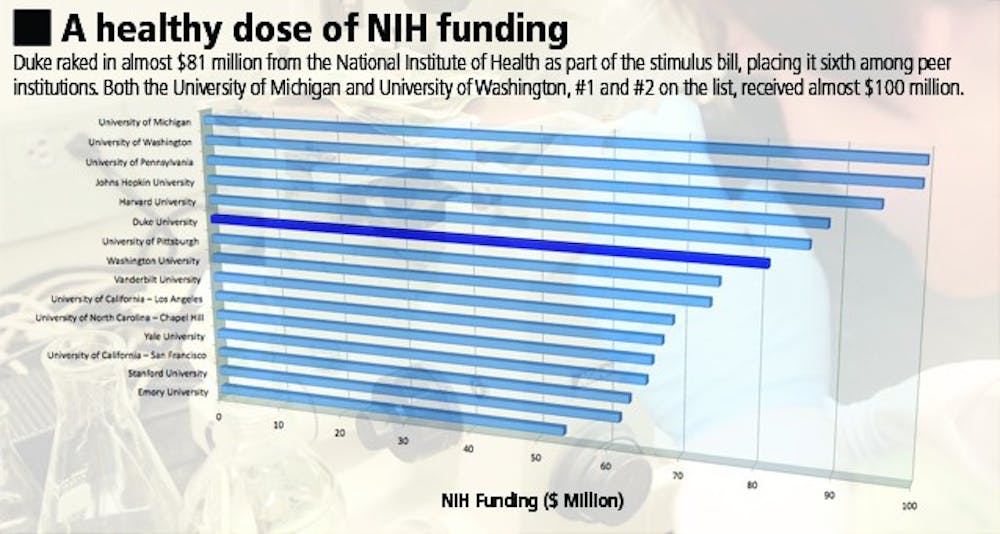As financial troubles lead to budget cuts, Duke is getting a boost from Uncle Sam.
Duke has received approximately $146.8 million in federal stimulus research funding. Of a total of 854 Duke proposals, 237 were approved.
The money from the stimulus bill, officially known as the American Recovery and Reinvestment Act of 2009, came to Duke primarily from four institutions: the National Institutes of Health, the National Science Foundation, the Department of Energy and the Department of Education, said Marianne Hassan, head of Duke’s ARRA Response Team and associate dean for new initiatives at the Pratt School of Engineering.
According to the Department of Health and Human Services—which administers the NIH, the largest source for grant approvals—Duke had 198 proposals approved by the NIH.
The total sum of funds from the NIH places Duke sixth among institutions in NIH stimulus funding, behind the University of Michigan, the University of Washington, the University of Pennsylvania, Johns Hopkins University and Harvard University, according to data from HHS.
“Last spring, the notion was that we [could receive] $100 million, and if things go really well, we could get $150 million,” Vice Provost for Research James Siedow said. “We exceeded our best expectations.”
Of the 237 approved projects, 163 were for the Duke University Medical Center and 74 were for the University, Hassan said. The 163 DUMC grants provide about $117 million in funds, and the 74 University grants provide $30 million. DUMC submitted 689 proposals and the University submitted 165, for approval rates of approximately 24 and 45 percent, respectively.
“If you look across the country, Duke did extremely well relative to its peers in terms of total ARRA funding” said DUMC Vice Dean for Research Sally Kornbluth. “Our success rate was great—under normal circumstances, some NIH institutes are only funding 8 to 10 percent each round [of total applications].”
Although the majority of the funding was supposed to conclude Sept. 30, a few proposals for infrastructure improvements are still being evaluated, Kornbluth said.
For example, a $15 million proposal that received good initial scores from NIH administrators has yet to be decided upon, Siedow said. He noted that a final decision may not occur until early 2010.
The $147 million provided by ARRA comes in two primary forms: extended paylines for previously approved proposals and new grants. Most of Duke’s ARRA research money is through increased budgets for existing projects, Hassan said.
Although a welcome boost in research spending after years of declining federal support, ARRA funding provides a short-term financial boon for institutes and research agencies that some fear may disappear once the economy returns to health.
“We really hope that the NIH will come to bat and really pick things up at the end of these two years, so the momentum gained during this two-year period can be maintained,” Kornbluth said. “But whether this will have a long-term impact will depend on what happens at the end of these two years.”
Of the $147 million, Siedow said roughly 75 percent is to cover direct costs—for expenses such as labor, material and equipment—borne by research teams. The remaining 25 percent is intended to cover the University’s indirect costs, such as administrative overhead, lab maintenance and electricity. The exact direct-indirect cost breakdown is determined on a grant-by-grant basis.
In a time of tough financial straits for Duke, the research funds provide some relief to an otherwise stretched University budget. Siedow said he does not expect ARRA funding to provide long-term solutions to current budget woes brought on by the recession.
“[ARRA] is a good influx of funding to the University, but it’s not long-term money. It’s only going to last a couple of years,” Siedow said. “This isn’t a panacea that gets us out of our recent budget problems.”
On the employment side, the additional funding has allowed the University to keep or add more than 100 positions, said Vice President for Human Resources Kyle Cavanaugh. The positions range from post-doctoral jobs to work-study spots for undergraduates. The long-term impact of ARRA funding on employment, however, remains unclear, especially given the short-term nature of much of the grant money.
“The overall intent is to stimulate a lot of activity that will spawn continuation and expansion in research and will retain positions as well as create additional opportunities,” Cavanaugh said. “I don’t think anyone has a great projection as to what happens two years from now and the final outcome of this, but our intent is to be as aggressive as we can in securing these funds as they become available.”
Get The Chronicle straight to your inbox
Signup for our weekly newsletter. Cancel at any time.

